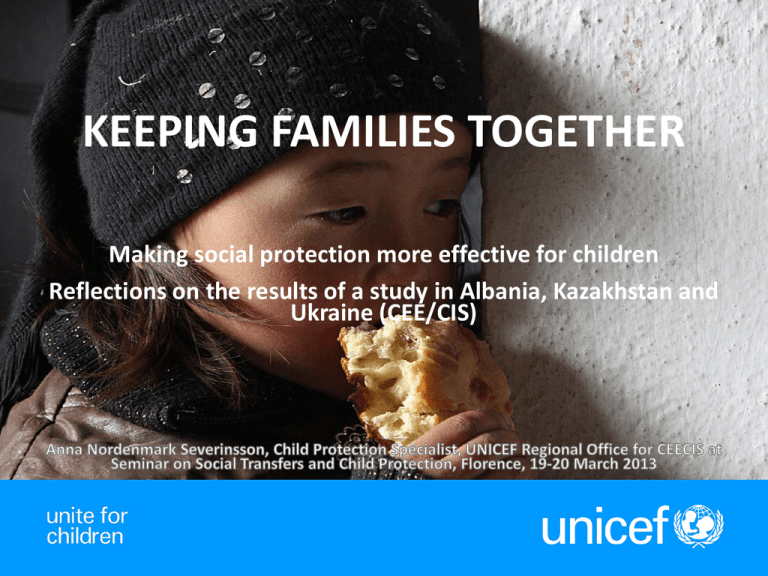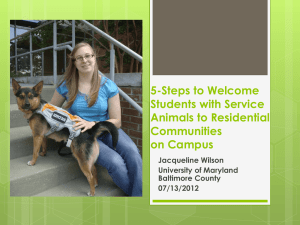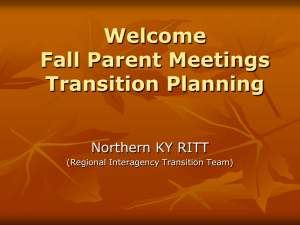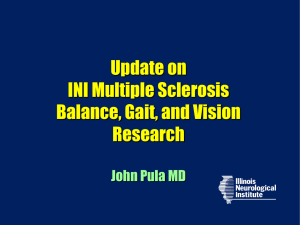Social Transfers - UNICEF Office of Research
advertisement

KEEPING FAMILIES TOGETHER Making social protection more effective for children Reflections on the results of a study in Albania, Kazakhstan and Ukraine (CEE/CIS) 1 Focus of the study: «Keeping families together – making social protection more effective for children» • • • • • • • Action research – to influence and advocate for reforms Hypothesis: separation of children from their families is an indicator of vulnerability of a family and can be prevented with a a combination of social assistance and social services (components of social protection). Research questions: What is the impact of current social assistance schemes and social services on the most vulnerable? What are the barriers to access of these (if any)? Timing: Research in 2011, in 2012 – global SP framework, repackage of findings Methodology: Mixed methods (desk review, qualitative and quantitative data collection and analysis) Sources of information: Survey data, semi-structured interviews with key (30/country) stakeholders, focus group discussions ( 4 groups w 10 participants each / country) with parents who are service users / receipients of SA and with services providers. Coverage: Albania (2 municipalities), Kazakhstan (3 regions) and Ukraine (2 regions): urban/rural Rationale for the research Reasons for the institutionalization of children below 3 years of age in Central and Eastern Europe countries Reasons for the institutionalisation of children below 3 years of age in Western Europe countries parental abuse or neglect parental abuse or neglect true orphans orphans disability disability social reasons social reasons Source: EU Daphné Programme (2004) 3 Background on CEE/CIS • 1.3 million children in alternative care, out of which 50% in large scale residential care – largest rate of alternative care placements in the world (?) – a result of the “pull-effect” of the system • Increasing separation of children from families in spite of efforts to ” reform ” the system rate per 100,000 children aged 0-17 Children in residential care and in the care of foster parents or guardians in 9 selected countries 2500 2000 1500 1000 Residential care 500 2000 2001 2002 2003 2004 Foster or guardian care 2005 2006 2007 Total in formal care 2008 2009 2010 Source: TransMONEE 2011 Database, UNICEF Regional Office for CEECIS, Geneva a. Children in residential care include children in infant homes, in orphanages, in boarding homes and schools for children without parental care or poor children, disabled children in boarding schools and homes, family-type homes, SOS villages, etc. Children in punitive institutions are normally excluded. Definitions may differ among countries. b. Foster parents are obliged to take care of the child personally. Guardian has the same rights as foster parents, but he is obliged to take care of the child personally and to replace fully the care of parents. Children w. disability over-represented in care and benefiting less from reforms 800,000 700,000 600,000 500,000 Total no of children in residential care (17 countries in CEECIS) 400,000 Total no of children with disability in residential care (17 countries in CEECIS) 300,000 200,000 100,000 2004 2005 UNICEF Regional office CEE/CIS 2006 2007 2008 2009 5 2010 Children under 3 in residential care – most vulnerable and not prioritized 800,000 700,000 600,000 500,000 Total no of children in residential care (in 15 countries in CEECIS) 400,000 Total no of children under age 3 in residential care (in 15 countries in CEECIS) 300,000 200,000 100,000 2004 2005 2006 UNICEF Regional office CEE/CIS 2007 2008 2009 6 2010 UNICEF’s work in child protection in CEE/CIS Cash transfers (including pensions, child benefits, poverty-targeted, seasonal) Social Transfers Food transfers Nutritional supplementation; Provision of ARVs Public works Birth registration Programs to access services User fee abolition Health insurance Exemptions, vouchers, subsidies Specialized services to ensure equitable access for all Support and care Family support services Home-based care Accessible Childcare services REFORM OF EXISTING SERVICES Minimum and equal pay legislation Legislation Employment guarantee schemes Maternity and paternity leave Removal of discriminatory legislation or policies affecting service provision/access or employment Inheritance rights UNICEF Social Protection Work an overview Show and Tell on Social Protection Bonn, 2011 SNAPSHOT OF FINDINGS - Access - Barriers to access - Impact - Barriers to impact Means tested poverty allieviation schemes Albania Ukraine Kazkhstan Ndime economie: Guaranteed minimum income scheme: Targeted social assistance Covers 33% of poorest and 67% of «non-poor» Coverage: 85% of expenditure on 20% poorest 86% of expenditures on 20% poorest Disqualifies landowners Other benefits are incl. in assessment of income Other benefits are incl. in assessment of income Take into account no of children in household Employment certificate required Take into account no. of children in houshold Take into account no of children in houseold Categorical benefits schemes Albania Ukraine Kazakhstan Disability benefit Birth grants Birth grants 0-3 years monthly child care allowance 0-1 year monthly child care allowance 0-18 years monthly child care alowance to single mothers Child disability benefit Disability benefit Carer allowance for parents to child with disability Carer allowance for parents to child with disability Benefits for families with 4 or more children Access to social assistance of most vulnerable • Countries have various social assistance benefits that children and parents can access • The infrastructure to administer them is extensive in all countries. • … but, the social benefits system is difficult to access and requiring a great deal of effort for little reward (as experienced by parents interviewed). • … and a large proportion of the recipients are the non-poor. • Categorical benefits are reaching higher proportions of the poorest families than means-tested schemes (especially the birth grants, 0-3 benefits and disability benefits) ATTENTION! • Social assistance benefits are most often targeted towards poverty alleviation and can only indirectly prevent family separation, dysfunctionality and disintegration. • Multiple vulnerability often does not qualify for multiple supports… families often have to chose between benefits. • Exclusion of certain groups limit impact: i.e. informal carers, landowners Gatekeeping and family support services Albania Kazakhstan Ukraine Statutory services CPUs Guardianship (courts) Medical commissions Child Protection Departments Psychological medical commissions Commissions of Minors Centers for social services Family and child support services Councelling Referrals and facilitating access to benefits and services (by CPUs) Crisis shelters Spec. Day care Social work in materity hospitals Rehabilitation services Outreach social work Social work in maternity hospitals Mother and baby units Day care Rehabilitation Access to social services of most vulnerable • Social services remain over-relying on residential care, even if there are pilot initiatives for inclusive education, rehabilitation services, therapy and community based services for children with disability and children from vulnerable families. • Embryonic case management and weakness of social work and the administrative and managerial infrastructure emerged as a key gap. – There is a lack of understanding about what social work is, how it differs from social assistance and what the functions and roles of a social worker are within the social protection system. – Tools of social workers, such as emergency social assistance, access to housing to respond to family crisis and acute risks of abandonment remain few. – Social workers report facing “demeaning attitude towards their profession, and little appreciation”. • Free legal aid exists in most countries, but is seldom used to challenge decisions made by the system on accessibility to social protection and decisions on placement of children in care “People do not want to complain as it costs money. Besides, I think people do not trust and do not believe in positive consequences of complaints” Parent, Ukraine Barriers to access 1: Lack of information about services, benefits “The mentality here is still very much related to money and not to different types of social services that they could have or would support them. There needs to be more public awareness of social services. This lack of understanding also impacts as a barrier to the approaches and work of the professionals”. Local government worker (after piloting professional social work for 18 months in one locality on the lack of demand for social work support, Albania “I have absolutely no clue where I can refer for support for my disabled child. What other types of benefits I can additionally get” Mother of disabled child, Albania Barriers to access 2: Stigma and discrimination against service users “The state institutions close the doors to Roma or Egyptian families, or do not provide the right information. When they finally manage to find the right office, the employer says; well I am sorry but you missed the deadline and you can not apply anymore. So those families do not have access because they lack information and do not know the rules, procedures and deadlines to apply to social benefits.” Frontline worker, Albania “Institutions….that provide services or cash benefits are often aggressive and rude to families with disabled children” – "They come and check often; they even check children’s bed… it is so humiliating” Parent, Kazakhstan Barriers to access 3: Complexity to application process • • Number and types of documents that have to be gathered by applicants, often at some expense: Application involves travel, stay overnight, (i.e. legacy of Soviet registration system - families without registration are not eligible for benefits. Those who have migrated to cities have to return to the place where they are registered.) “They wrote a wrong letter in the name N., made a mistake. They said that I should redo it, so I had to come again, It is really hard, we save money for travel, we arrive and then we stay hungry all day. Just because of one wrong letter they force us to rewrite a document. We do the correction, we come again next day but the specialist is not there. Or, sometimes you give them a document, but they don’t know what to do with it. Because the person who is responsible is not informed enough. We also have to pay for all photocopies of these documents”. Parent, Kazakhstan Impact 1: In spite of weaknesses – impact can be achieved “I am very satisfied with the support I received especially at the beginning. When I gave birth to my child they [social workers] helped me significantly. I did not have any money at all. They bought diapers even. Later they helped me to gather all the necessary documents to apply for social benefits. And now they also call me and ask whether any further assistance is needed.” Young mother with child under 1, Ukraine “Social services help families, they help to assess situations in adequate manner, they make families to feel more secure, they help to find solutions”. Grandfather, guardian of his granddaughter, Ukraine “If I did not receive this [service provided by NGO]…I would die or I would place have to place my children into an orphanage”. Formal kinship carer, Albania Impact 2: Impact is not maximized for a number of reasons • Disintegration of social protection systems leads to limited impact to address other risks than most acute poverty. • Lack of supply: Incl. types of services, equitable distribution, cost of services, quality of services and bureaucracy - limit the impact on vulnerable families of existing social protection mechanisms and services. • Lack of outreach: Social assistance and social services systems tend to be reactive rather than pro-active. The services and benefits systems do not reach out to actively seek and engage with their target groups. Parents and carers therefore need to work really hard to access them. • Lack of mechansims for creating synergies between policies and practical integration of the system (i.e. sharing information systems on beneficiaries, comprehensive assessments on needs and contexts to guide delivery of comprehensive set of interventions, multi sectoral coordination etc.) Impact 3 – some people are more likely to miss out… those who need it most…? • Multiple factors seem to contribute to greater vulnerability: poor, rural and disability – it requires an integrated response which is not the current practice (services and benefits) • Families with children with disabilities have least access to appropriate, relevant and responsive services – being a group of children who are over-represented in care in CEE/CIS this is of course alarming • Stumbling blocks to accessibility of services and benefits often multiply if you have a disability and reforms have not changed this. UNICEF Social Protection Work an overview Show and Tell on Social Protection Bonn, 2011 CONCLUSION: OPPORTUNITIES AND CHALLENGES Implications for system design to achieve better impact • Synergies, synergies and integration… of policies and systems for social assistance and social serfices • Outreach (both assistance and services) recruitment of child protection cases (for benefits) • Active • Recognition of multiple factors to vulnerability: Net better than brut when deciding on entitlements • Considerable investment at • Focus on birth and early years disability Opportunities for linkages • • • • Institutional – mandate for social assistance and child protection rests in many countries with the same ministry, BUT… “old” assistance and services still occupy the space and absorbs most budget Organizational – On the ground, the responsibility for determining eligibility for social assistance often rests with social welfare officers (social administartors etc.) BUT… these officers end up spending most of their time on gatekeeping and administrative duties related to social assistance, rather than case management for child protection. Re-profiling and emergence of social workers, expansion of this profession also through intro. Of modern social work university courses and re-training programmes, in parallel with reforms in social assistance programmes is a great opportunity. Objectives – As seen in CEE/CIS, gaps in social protection places burden on child protection system. In changing focus from poverty alleviation (minimum level of income) to minimum level of well-being there will be greater opportunities for synergetic effect (both to achieve poverty reduction and greater child protection outcomes). Should we also look North for some best practices in design of integrated SP systems? Target groups – Many households with children in need of protection will also be the ones who are vulnerable to poverty – so there might be an automatic synergetic effect. BUT only if poverty is the single cause, more complex cases (majority?) will need a combination of supports.








